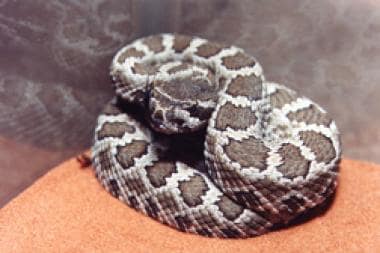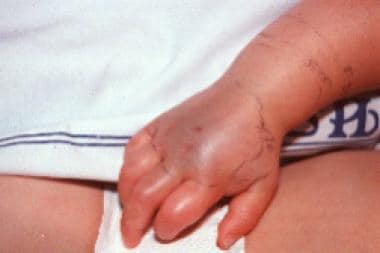Practice Essentials
Rattlesnakes are pit vipers and include the genera Crotalus and Sistrurus. Pit vipers may be identified by a heat-sensing pit anteroinferior to the eye. Rattlesnakes may be identified in all but one species by a rattle at the tip of the tail. Rattlesnakes are indigenous from North America to South America. See the image below.
Signs and symptoms
Also see Presentation.
Physical examination findings after a rattlesnake bite and/or envenomation may include the following:
-
Tenderness surrounding the bite site
-
Local edema: Use a pen to mark and time the border of advancing edema every 15-20 minutes initially. Once stabilization with antivenom has occurred, repeat measurements every 1-2 hours. Rapidly progressive swelling is usually indicative of a severe envenomation.
-
Erythema
-
Ecchymosis
-
Bullae
-
Bleeding
-
Hypotension/hypertension
-
Tachycardia
-
Myokymia (muscle fasciculations)
-
Neurologic effects
-
Lethargy
Diagnostics
Please see Workup.
Management
See Treament and Medication for a full discussion.
Adequate hydration with intravenous fluids is indicated. Patients with hypotension should be resuscitated first with two isotonic sodium chloride solution challenges (eg, 20 mL/kg). Treat persistent shock with colloids, followed by pressors as indicated.
Administer antivenom for signs of envenomation progression or imminent risk of an acute complication of envenomation (see Complications). Crotalidae polyvalent immune FAB ovine (CroFab) is a safe option [1, 2] and it is indicated even if the envenomation is minimal or mild. [3, 4] An equine Crotalidae immune FAB antivenin was approved in the United States in 2015. An antivenin should be given as a preventative measure if any signs of envenomation exist. Do not wait for the envenomation to get worse—permanent injury could result.
It is emphasized that grading envenomations is a dynamic process and additional antivenom should be given as indicated by a worsening clinical course. [5] When considering the use of antivenom, the risk of adverse reaction to antivenom must be weighed against the benefits of reducing venom toxicity. [6] Alternatives (eg, a different type of antivenom, if available) should be considered as well.
It should be noted that a retrospective review of 21 cases of male patients with C horridus (timber rattlesnake) envenomation, patient age 19-71, found severe thrombocytopenia despite antivenom administration. While there were no deaths and no red blood cell transfusions required among this patient group, the mean time to platelet count recovery was 10 days after envenomation. [7]
Nonenvenomation, ie, dry bite (probably occurs in < 10% of rattlesnake bites, although estimates as high as 50% exist), is characterized by the following:
-
Local effects - Puncture wounds only
-
Systemic effects - None
-
Coagulation abnormalities - No laboratory evidence of coagulation abnormalities and no clinical evidence of abnormal bleeding or clotting
Minimal or mild envenomation is characterized by the following:
-
Local effects - Swelling, pain, tenderness, and/or ecchymosis confined to the immediate bite area
-
Systemic effects - None
-
Coagulation abnormalities - No laboratory evidence of coagulation abnormalities and no clinical evidence of abnormal bleeding or clotting
Moderate envenomation is characterized by the following:
-
Local effects - Swelling, pain, tenderness, and/or ecchymosis extending beyond the immediate bite area but involving less than the entire part
-
Systemic effects - Present but not life threatening; may include nausea, vomiting, oral paresthesias or unusual tastes, fasciculations (myokymia), mild hypotension (systolic blood pressure < 90 mm Hg), mild tachycardia (heart rate < 150 bpm), and tachypnea
-
Coagulation abnormalities - Laboratory evidence of coagulation abnormalities may be present, but no clinical evidence of abnormal bleeding or clotting exists; rattlesnake venom-induced coagulopathies commonly include thrombocytopenia, decreased fibrinogen, and/or elevated PT
Severe envenomation is characterized by the following:
-
Local effects - Swelling, pain, tenderness, and/or ecchymosis extending beyond the entire extremity or threatening the airway
-
Systemic effects - May include severe hypotension or shock, severe tachycardia or tachypnea, respiratory insufficiency, and/or severe altered mental status
-
Coagulation abnormalities - Markedly abnormal with serious bleeding or severe threat of bleeding
Pathophysiology
Venom is usually injected into subcutaneous tissue via hollow movable fangs located in the anterior mouth. Occasionally, intramuscular or (probably rarely) intravenous injection occurs. Rattlesnake venom is generally composed of several digestive enzymes and spreading factors, which result in local and systemic injury.
Clinically, local effects most commonly predominate, progressing from pain and edema to ecchymosis and bullae. Hematologic abnormalities, including defibrination with or without thrombocytopenia, may result, but serious bleeding is uncommon. [8] Local or diffuse myotoxicity may result in complications such as compartment syndrome [9] or rhabdomyolysis. Other general effects include shock, myokymia/fasciculations, taste changes, and vomiting. Rarely, direct cardiotoxicity or allergy to venom may occur. Some rattlesnakes may exhibit neurotoxicity with minimal local tissue effects (see Mojave Rattlesnake Envenomation).
Etiology
A large percentage of bites occur when a snake is handled, kept as a pet, or abused. These are considered intentionally interactive bites. Many bites are associated with ethanol use.
Epidemiology
Frequency
United States
According to the American Association of Poison Control Centers (AAPCC) 2016 Annual Report, 804 rattlesnake envenomation case mentions were reported in 2016, with an additional 994 unknown crotalid envenomations. [10] In total, approximately 6,000 various snake envenomation case mentions were reported in 2016. However, this figure is probably conservative because of underreporting. Rattlesnakes cause the majority of all bites by identified venomous snakes in the United States. [11, 12] Dry bite (ie, no clinical evidence of envenomation) occurs in 10-50% of strikes. The American College of Medical Toxicology established the North American Snakebite Registry (NASBR) in 2013 to collect information about the epidemiology, clinical course, and management of snakebites. Between 2013 and 2015, 14 sites in 10 states entered 450 snakebites into the database. [13]
International
An estimated 300,000-400,000 venomous snakebites occur per year. Although rattlesnakes are not found naturally outside of North America, Central America, and South America, they are imported into zoos, museums, and private collections in other regions of the world.
Sex and age
Males are bitten more commonly than females.
Young adults are bitten most commonly. [14] Elderly patients may have comorbidities and take medications that may increase the risk of hemotoxicity. [15]
Prognosis
Before antivenom, estimates of mortality rates ranged from 5-25%.
Since the development of antivenom, rapid EMS transport, and emergency/intensive care, mortality rates have improved to less than 0.28% when antivenom is administered and to 2.6% when antivenom is not administered.
Less specific figures are available for morbidity data, although most patients recover fully after rattlesnake envenomation. The best estimates suggest that rattlesnake envenomation results in tissue loss, deformity, or loss of function in approximately 10% of patients.
Mortality/morbidity
Fewer than half a dozen deaths occur per year as a result of snakebite in the United States; most are caused by rattlesnake bites. Estimates of deaths each year from snakebite range from 30,000-110,000 worldwide. Up to 5 times as many individuals experience permanent morbidity. [16, 17]
US mortality with administration of antivenin is approximately 0.28%. Without antivenin being administered, mortality is approximately 2.6%.
Patient Education
Call professionals, such as animal control, to move snakes (if it is necessary to move the snake).
Never attempt to handle, possess, or kill venomous reptiles.
-
Juvenile southern Pacific rattlesnake (Crotalus oreganus helleri). Photo by Sean Bush, MD.
-
A recent study suggests that the Extractor (Sawyer Products) does not reduce swelling after rattlesnake envenomation and may be associated with skin necrosis beneath the suction cup. Photo by Sean Bush, MD.
-
Moderate rattlesnake envenomation in a toddler after treatment with antivenom. Photo by Sean Bush, MD.











